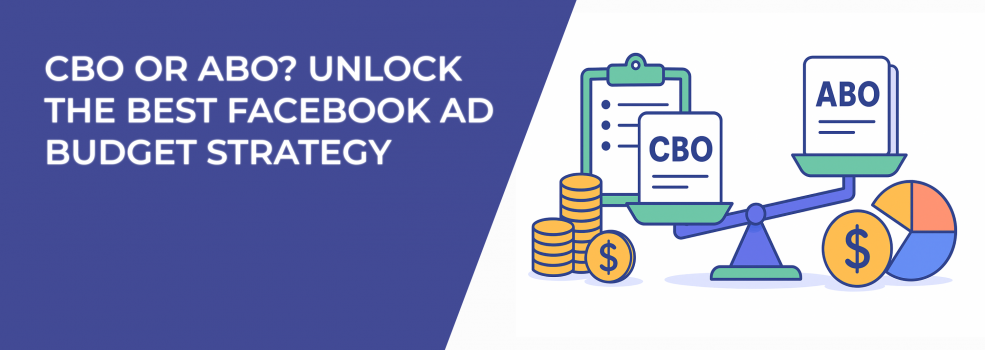If you’re spending more than a few dollars a day on Facebook or Instagram ads, you’ve probably faced a classic question: should I go with CBO or ABO?
It sounds technical, but your decision here could mean the difference between a campaign that quietly burns your budget and one that thrives with better results for less spend.
So let’s unpack both, make sense of how they actually behave in the real world, and help you choose the smartest strategy for your next campaign.
What’s the Difference Between CBO and ABO?
Before we get too deep, a quick update: what used to be called CBO (Campaign Budget Optimization) is now officially called Advantage Campaign Budget.
Meta’s naming conventions may keep evolving, but the fundamentals behind how these systems allocate budget haven’t changed much — yet how you use them definitely should.
At its core, the difference lies in where your budget is controlled.
-
With ABO (Ad Set Budget Optimization), you assign specific budgets to each ad set. You decide how much each audience gets, regardless of performance.
-
With CBO (now Advantage Campaign Budget), the campaign itself controls the budget. Facebook’s algorithm distributes spend across ad sets in real time, depending on what’s performing best.
Sounds straightforward, right? But here’s where it gets tricky.
Just because the algorithm is smart doesn’t mean it’s always right. And just because you control your spend manually doesn’t mean you’re in total control.
So which should you choose? That depends on what you’re trying to do and how much data you already have.
When to Use ABO: You’re the One Holding the Reins
ABO gives you precision. If you want total control over how much budget each audience gets, ABO lets you set hard limits. That’s especially helpful when you’re testing.
Let’s say you’re running ads to five different interest-based audiences. You don’t know yet which one will perform best. With ABO, you can ensure each audience gets an equal share of the spend — and equal opportunity to prove itself.
ABO works well when:
-
You’re running audience tests and want equal distribution,
-
You’re working with segmented strategies, like lookalikes vs. retargeting,
-
You need to ensure budget fairness across new or unproven audiences,
-
You’re managing a lower budget and want to prevent overspending on one audience.
This is also useful when you’re dealing with retargeting pools, email-based custom audiences, or niche segments. You can protect your high-intent traffic from being drowned out by broader prospecting groups.
But here’s a hidden drawback: ABO doesn’t adapt. If one audience is clearly outperforming the others, you’ll have to manually shift the budget yourself. No automation, no real-time flexibility.
Use ABO if you want:
-
Full control over spend per ad set,
-
Equal testing conditions across audiences,
-
A structured, predictable spend strategy.
Pro tip: use ABO when running experiments. Once you know what’s working, consider shifting to CBO to scale more efficiently.
When to Use CBO (Advantage Campaign Budget): Let the Algorithm Work
CBO thrives when you’ve got a clear goal and a decent amount of historical data.
This strategy lets Meta's algorithm move your budget between ad sets to maximize results. If one audience is converting at a lower cost, the system will naturally push more budget in that direction.
It’s great for scaling. If you’ve already tested creatives and audiences and you know what works, CBO helps you grow without constant micromanagement.
CBO is ideal when:
-
You’re ready to scale a proven strategy,
-
You have winning creatives and audiences from earlier tests,
-
You want Meta’s algorithm to optimize based on live performance signals,
-
You’re managing a larger daily budget and want efficient spend allocation.
That said, it’s not magic. Many advertisers turn on CBO and wonder why certain ad sets barely spend. Others get flooded with budget, but conversions plateau.
That’s because the algorithm is only as good as the structure you give it. Without proper audience segmentation, tested creatives, and clearly defined objectives, CBO can easily favor one ad set while starving others even if they might’ve performed better in time.
To get the most out of CBO, make sure you:
-
Avoid mixing different funnel stages (e.g., cold traffic vs. warm leads),
-
Use strong-performing ad sets that are ready for scaling,
-
Monitor how the algorithm distributes budget — don’t assume it’s always right.
Tip: make sure all ad sets within a CBO campaign are strong contenders. Don’t mix radically different audience types — like cold vs. warm traffic — in the same CBO campaign. It leads to lopsided delivery that’s hard to fix after the fact.
Want to get the most out of CBO? Here’s how to optimize Advantage Campaign Budget for scalable results without wasting spend.
What About Budget Efficiency?
Here’s a question every advertiser asks sooner or later: Which one gets me more conversions for less spend?
And the answer isn’t one-size-fits-all.
-
CBO tends to optimize for volume and cost-efficiency — especially once you've identified your top audiences.
-
ABO gives you more predictability, but can also result in underperforming ad sets eating into your budget.
If your daily budget is on the lower side (think under $100/day), ABO might help you spread that spend more intentionally. But if you’re spending at scale and you’ve got enough conversions to feed the algorithm, CBO can help unlock more consistent, lower-cost results.
Mixing Both: Can You Have the Best of Both Worlds?
Absolutely. In fact, some of the most seasoned media buyers start with ABO to test and then move into CBO for scaling. It’s a natural progression.
Imagine launching a campaign with four different ad sets — each targeting a different audience. You run them for a week under ABO, gather performance insights, and identify which audiences are converting under your target CPA.
Then you relaunch those top-performing ad sets in a CBO campaign, let the algorithm run free, and focus on scaling.
Here’s what a hybrid approach can look like:
-
Start with ABO to evenly distribute budget across different audiences or creatives.
-
Run the campaign long enough to gather statistically significant performance data (typically 3–7 days).
-
Analyze the results to identify which ad sets are driving the most efficient results.
-
Pause underperforming ad sets and note the winners.
-
Move winning ad sets into a new CBO campaign to maximize efficiency and scale your spend.
This gives you the best of both worlds — precision during testing and algorithmic efficiency during scaling. It’s a methodical way to grow your results without gambling your budget on unproven assumptions.
Common Pitfalls to Avoid
Whether you go with ABO or CBO, some mistakes can sabotage your performance before your ads even go live.
-
Using too many ad sets in a CBO campaign — the budget spreads too thin, and the algorithm never gets enough data on each one.
-
Combining different funnel stages in the same campaign — don’t put cold audiences and retargeting in the same CBO. The system will always favor the lower-hanging fruit.
-
Ignoring performance signals — if one ad set never gets spend in CBO, it doesn’t always mean it's bad. Sometimes it just needs a bit more room to prove itself. Test it separately in ABO if you’re unsure.
Even the best strategy can underperform if the structure underneath it is flawed, so take the time to set up campaigns with intention, not just speed.
Final Takeaway
Choosing between ABO and CBO isn’t about picking the “right” method — it’s about matching your budget strategy to your campaign goals, your data, and where you are in the ad cycle.
Start with control, then move into automation when you’re ready to scale. And no matter which route you take, keep testing, stay curious, and let results, not assumptions, guide your next move.

